1934 McQuay-Norris Streamliner
-
Presenting the 1934 McQuay-Norris Streamliner.
First, the history --
In 1932, the McQuay-Norris Manufacturing Co., a St. Louis, Missouri, firm specializing in pistons, rings, bearings and other engine and chassis components, commissioned a series of streamlined automobiles that would act as rolling test beds for the parts they manufactured, and as rolling billboards and attention-getters. The task of building the cars fell to Cincinnati, Ohio's Hill Auto Body Metal Company.
Apparently there really wasn't any reason for the aerodynamic teardrop styling other than to attract attention, even though it did reportedly help increase the vehicle's top speed over the Ford cars that it was based upon. All of the drivers were young graduate engineer who had been hired and trained specifically for the work, and they were required to rebuild the engine in their vehicle with McQuay-Norris parts, thus providing adequate first-hand testimonials as to the fitment of the parts. For reliability, the vehicle itself provided proof of the durability of the components.
The cars traveled many thousands of miles on the roads of the U.S., Canada and Mexico between 1934 and 1940. They were then sold off, with some of them being used as delivery trucks, and one reportedly displayed on the roof of an auto parts store until it, too, disappeared.
The Lone Survivor
Michael Shoen, an Arizona attorney and investment manager, became facinated with the Streamliners after reading a 1972 article about them,and began to search for any remaining cars. It took three years, but he finally managed to track one McQuay-Norris car to a shop in Columbus Ohio. Unfortunately, it was in very sad condition. It had stood outside for some 20 years, and the wooden body framing was severely dry-rotted. All the Plexiglas windows were broken and mostly gone, and the metal panels had collapsed onto the frame, with the fenders wedged against the tires.
It took another three years for Shoen to convince the owner to sell him the car. For the restoration, he turned to Elwood Pullen, an elderly craftsman in Elmira, New York. Pullen had retired from Schweitzer Aircraft, where he had been foreman of their prototype and fabrication shops. He worked on restoring the Streamliner for several years before passing away.
Shoen had the car hauled back to Arizona in 1982, and began looking for someone to finish the restoration and to rebuild the dials. Three dials were missing, including the all-important blow-by meter. These parts were never found. He finally found someone to paint and upholster the car and to overhaul the mechanicals and to refurbish those instruments that were still intact. Over the years, he'd managed to do a lot of research, including talking to several of the long-retired McQuay-Norris engineers who had driven the streamliners when they were new.
Shoen felt that the car was as correct as anyone could make it, and it became driveable in 1990, twelve years after he had bought it.
Ten years later Shoen sold the car to Hemmings Motor News, where it was used for the occasional parade and displayed during Hemmings' annual open house events. At some point (haven't been able to determine just when) the Lane Motor Museum, located in Nashville, TN, aquired the Streamliner, where it is still on display.
Some articles state that there are actually two surviving cars, but there is never a mention of where that second one might be.Bodies were constructed of steel sheet metal attached to wood framing, with the exception of the doors, which were aluminum. Windshield wipers were not included in the design. Reportedly, the company engineers who drove the streamliners noted that the faster they drove, the more visibility improved during rainy drives, as the water rolled back thanks to the rounded Plexiglas front window panes.
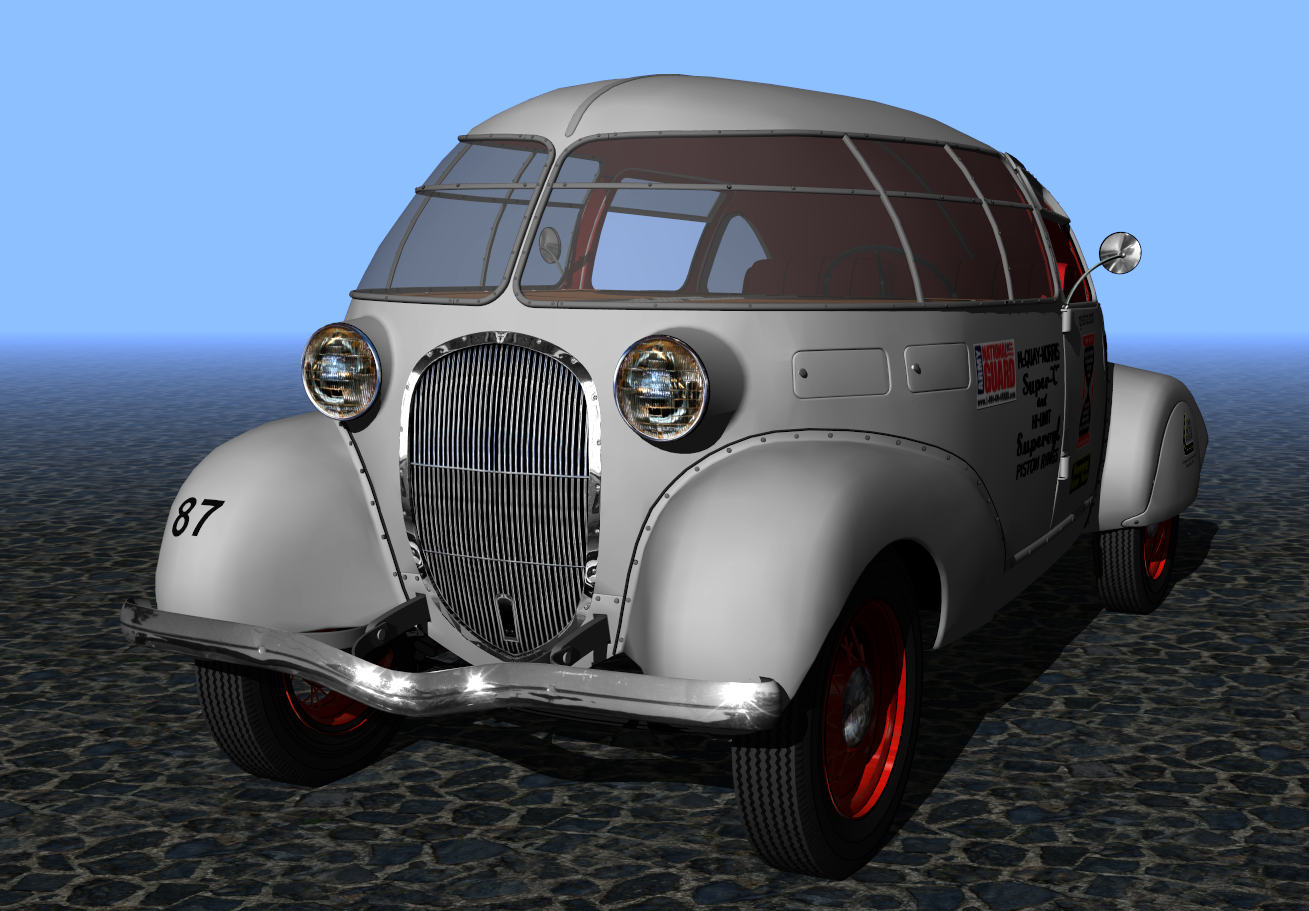
The restored Car No.9 demonstrated it's roadworthiness by completing the 2005 Great Race, traveling from Washington, DC to Tacoma, WA. Most of the decals on car are a result of that race.
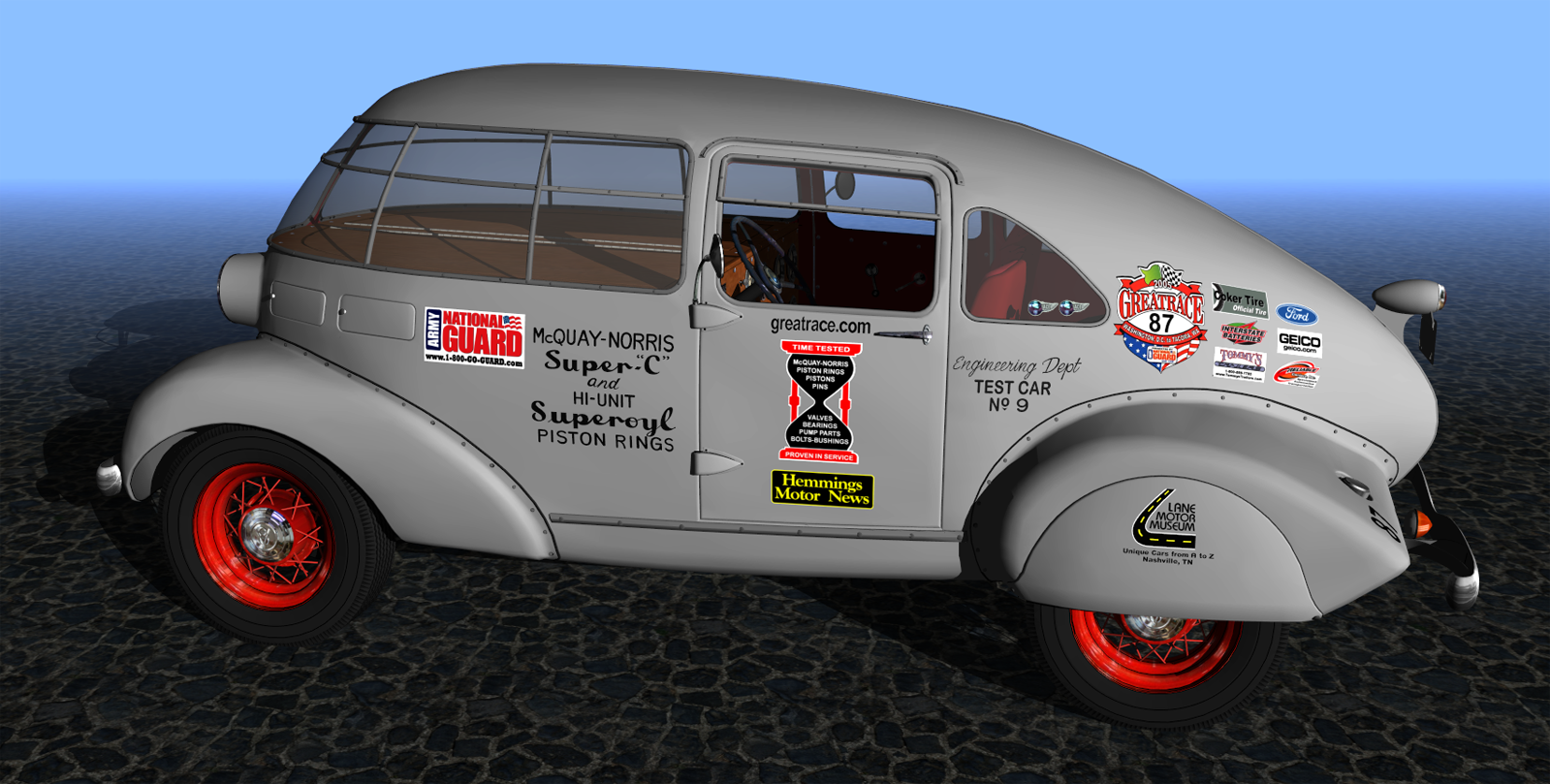
Here is how it would have looked when the cars were traveling the country, minus the extra decals and tail lights.
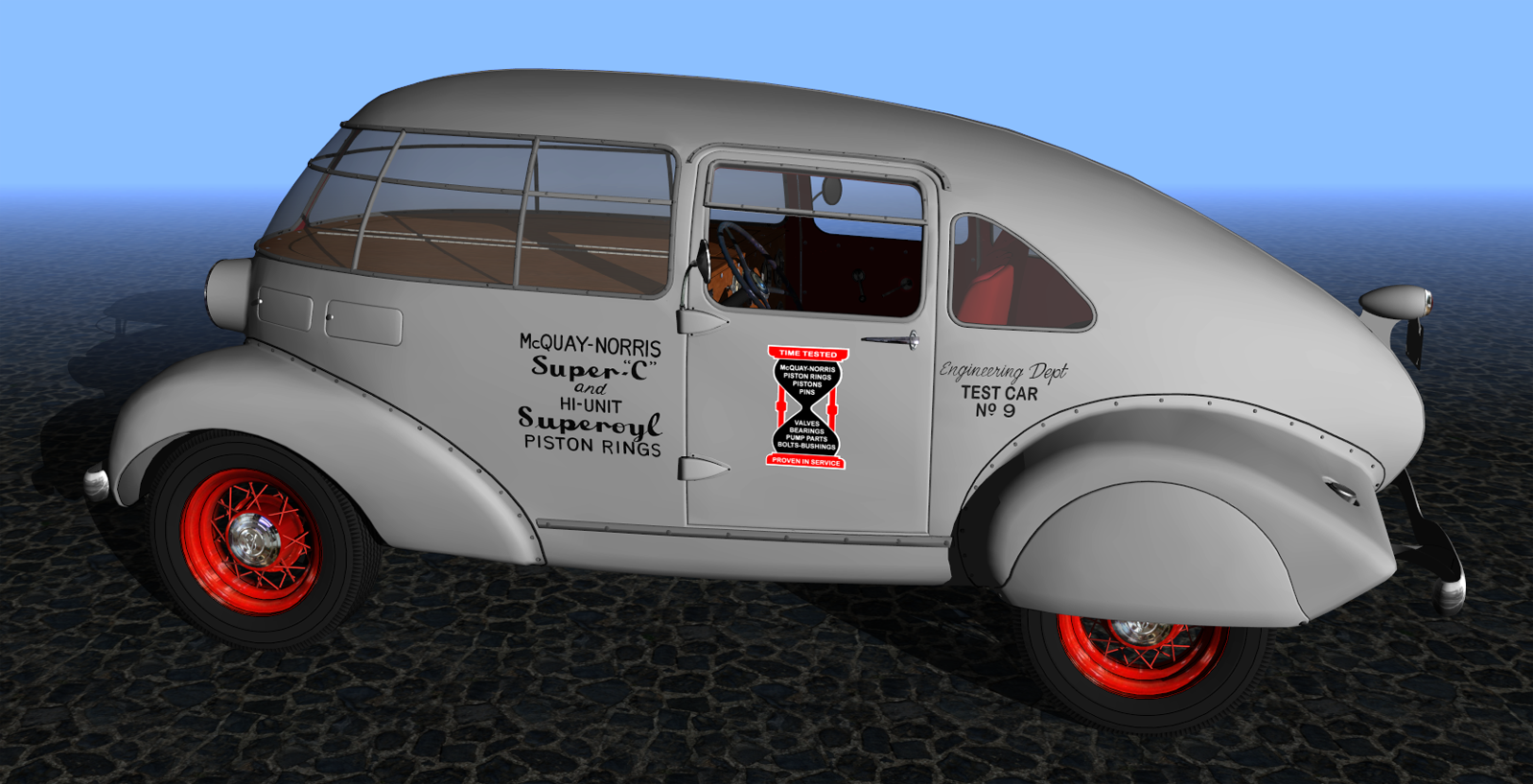
Unmodified 1932-33 Ford V-8 chassis and engines were used as the basis for the six Streamliners. The McQuay-Norris rode on General Jumbo Airwheels, which were much larger than the stock Ford rolling stock, though the stock suspension system was retained. Rearward visibility was very limited, utilizing two small mirrors attached to the doors.

There were no less than fifteen different gauges to monitor various aspects of the health of the drivetrain. Most were housed in a large wooden bulkhead that covered the engine in front of the driver; behind the driver was a blow-by gauge that measured the levels of unburned gases in the exhaust and acted as a wear indicator for the piston/ring assemblies. Some of the other gauges that provided relative analysis of the performance of the McQuay-Norris components included exhaust gas analyzer, viscometer, exhaust gas temperature, compression, vacuum gauges along with more common dial indicators for engine oil level, pressure and temperature, water temperature and ammeter, and an accuracy refined speedometer and odometer.
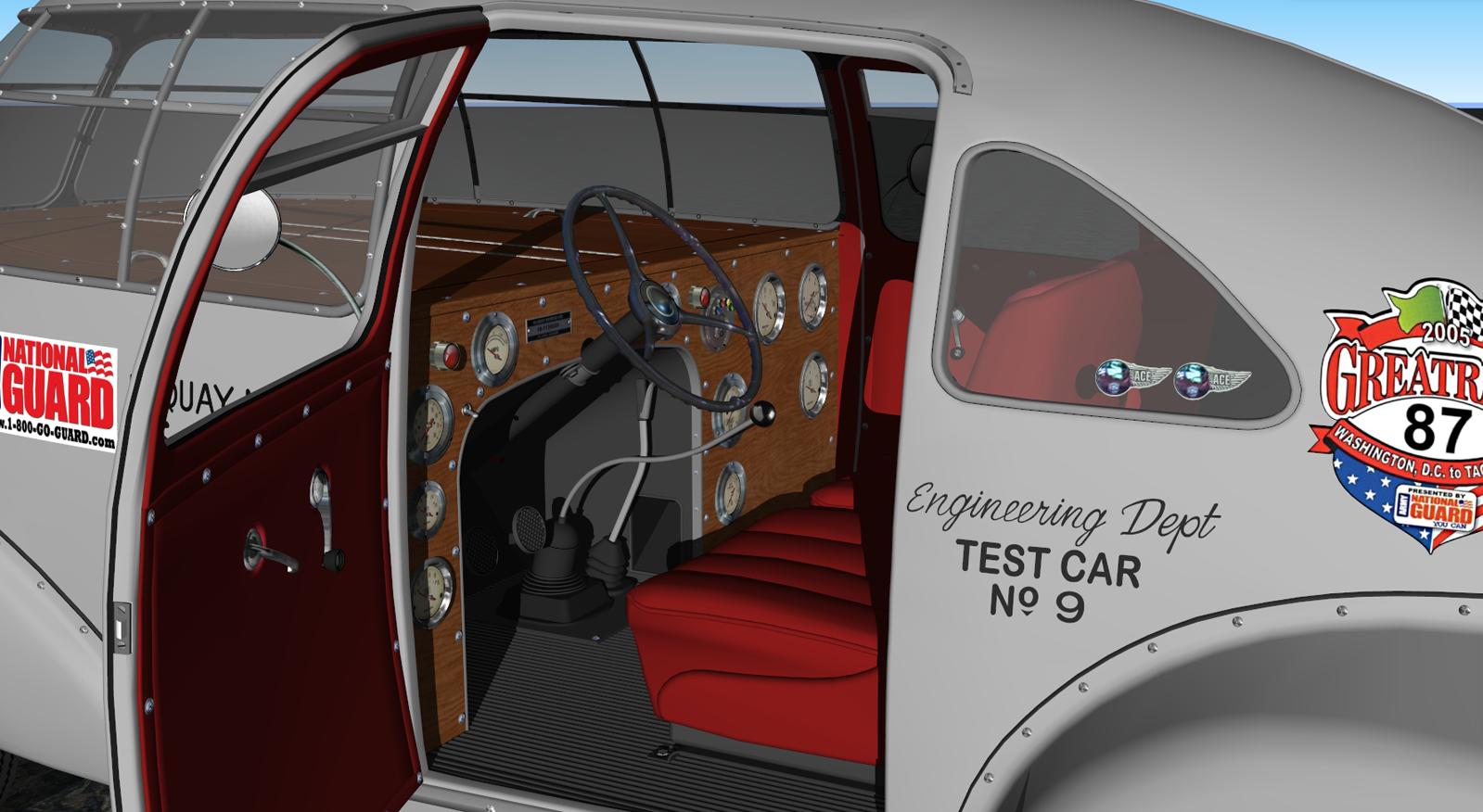
I assumed the two doors on each side were for ventilation purposes, but I did come across a vague reference to two panels that allowed the driver to check engine fluid levels, so maybe this is what they were for. The two "doors" in the wood deck opened to give access to the engine, and, as far as I can determine, were the only way to do any engine work. Must have been very uncomfortable.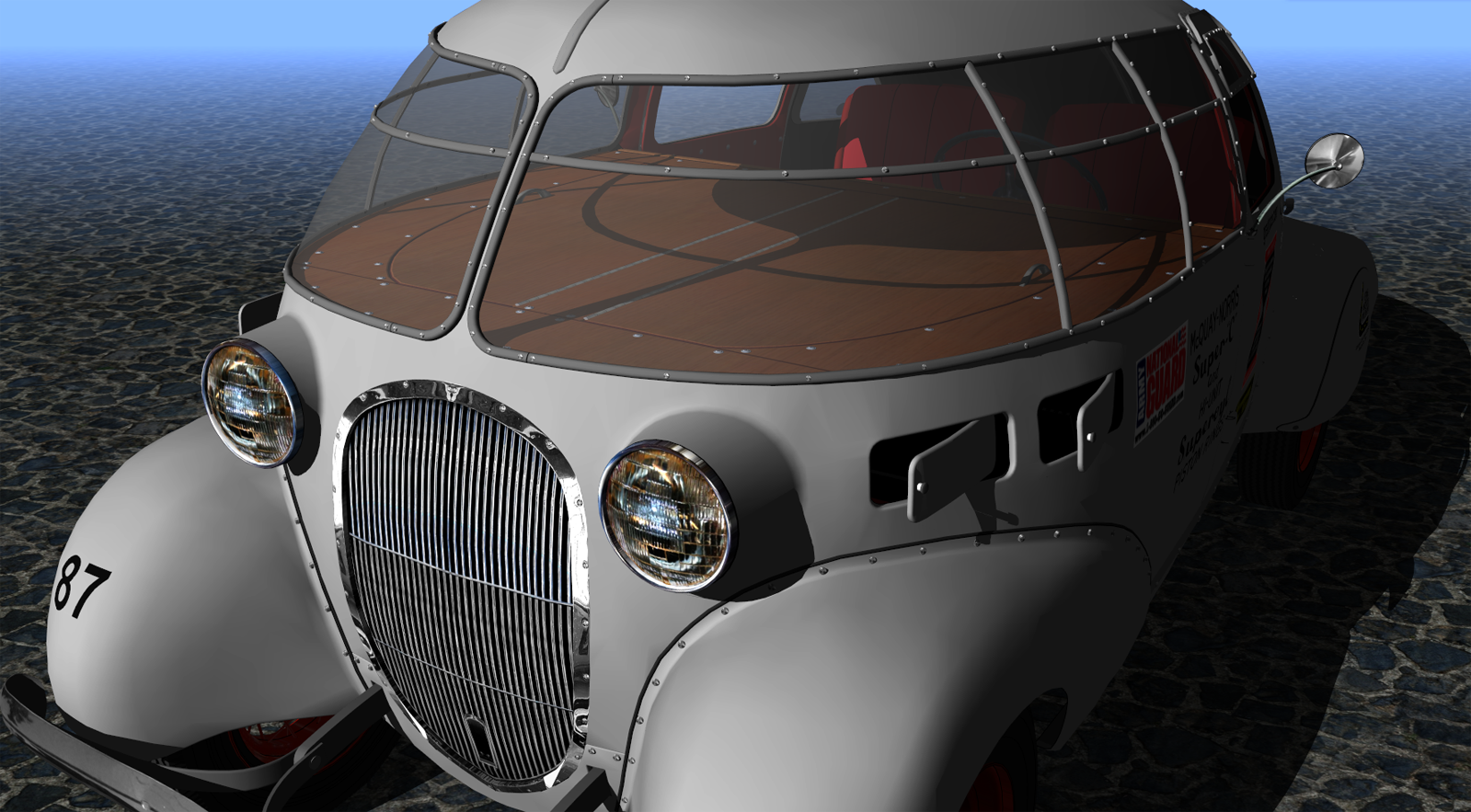
I imagine a number of drivers were surprised to see this bug-eyed beast in their rear-view mirror.
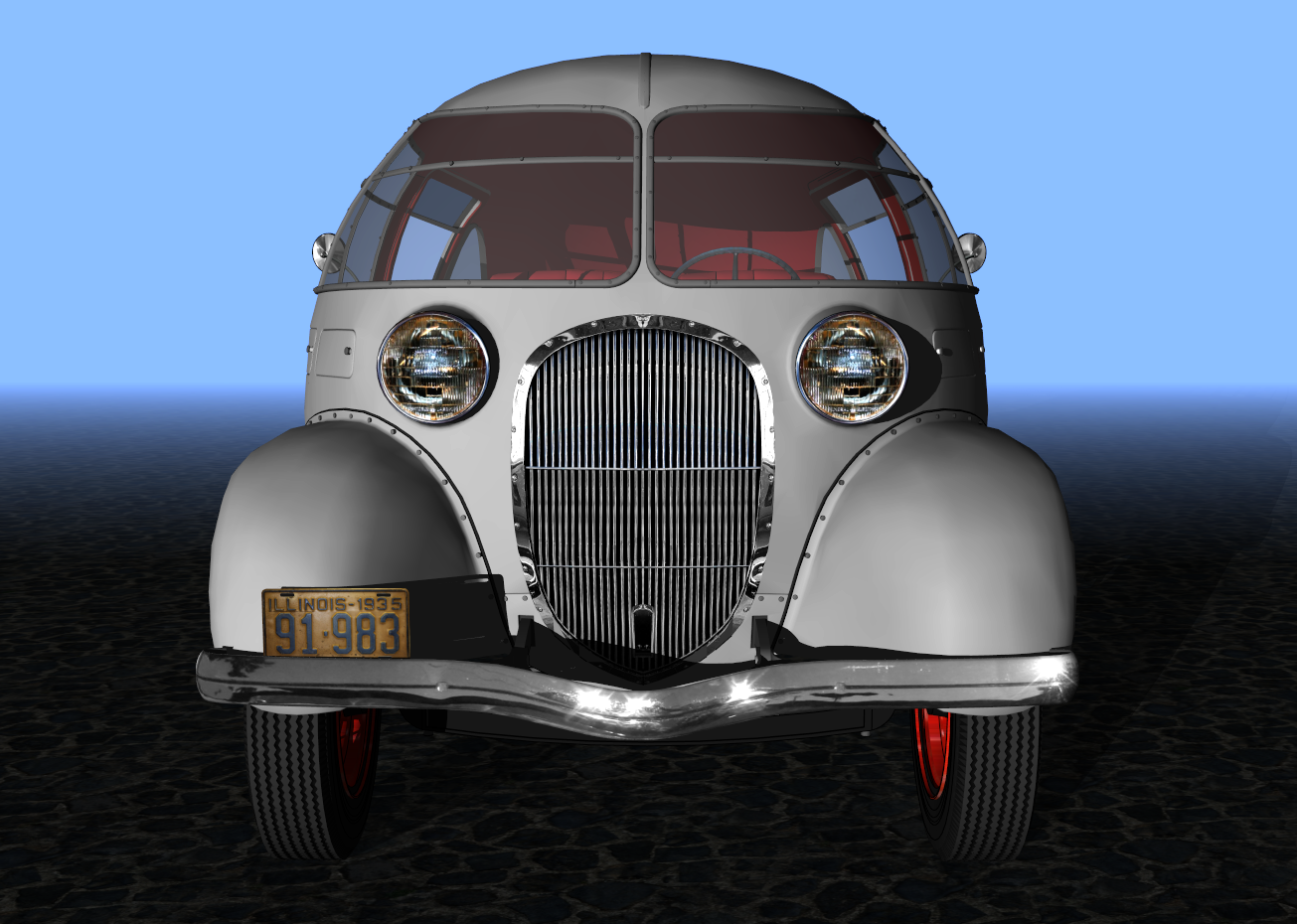
The cars attracted crowds wherever it appeared, and this pamphlet was distributed to answer some of the anticipated questions.
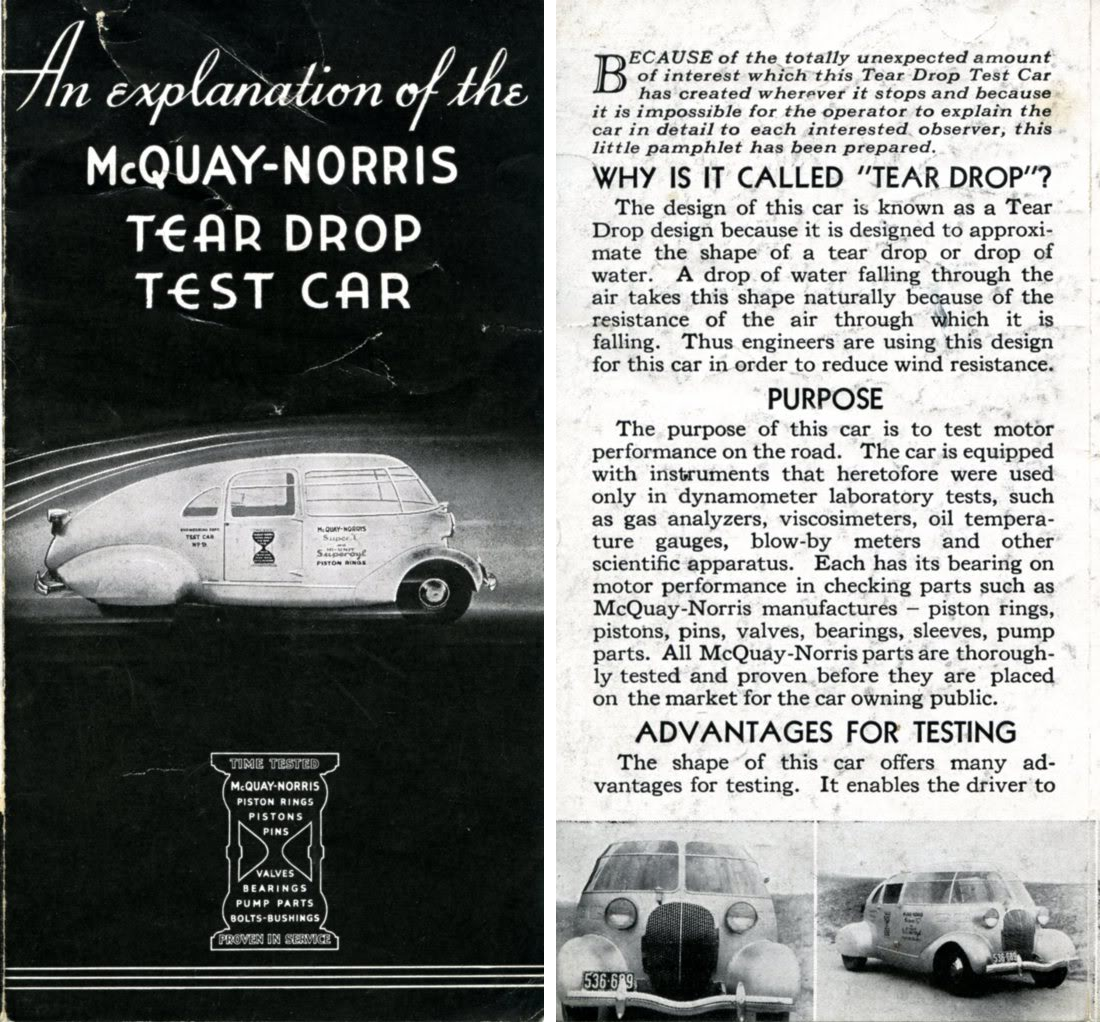
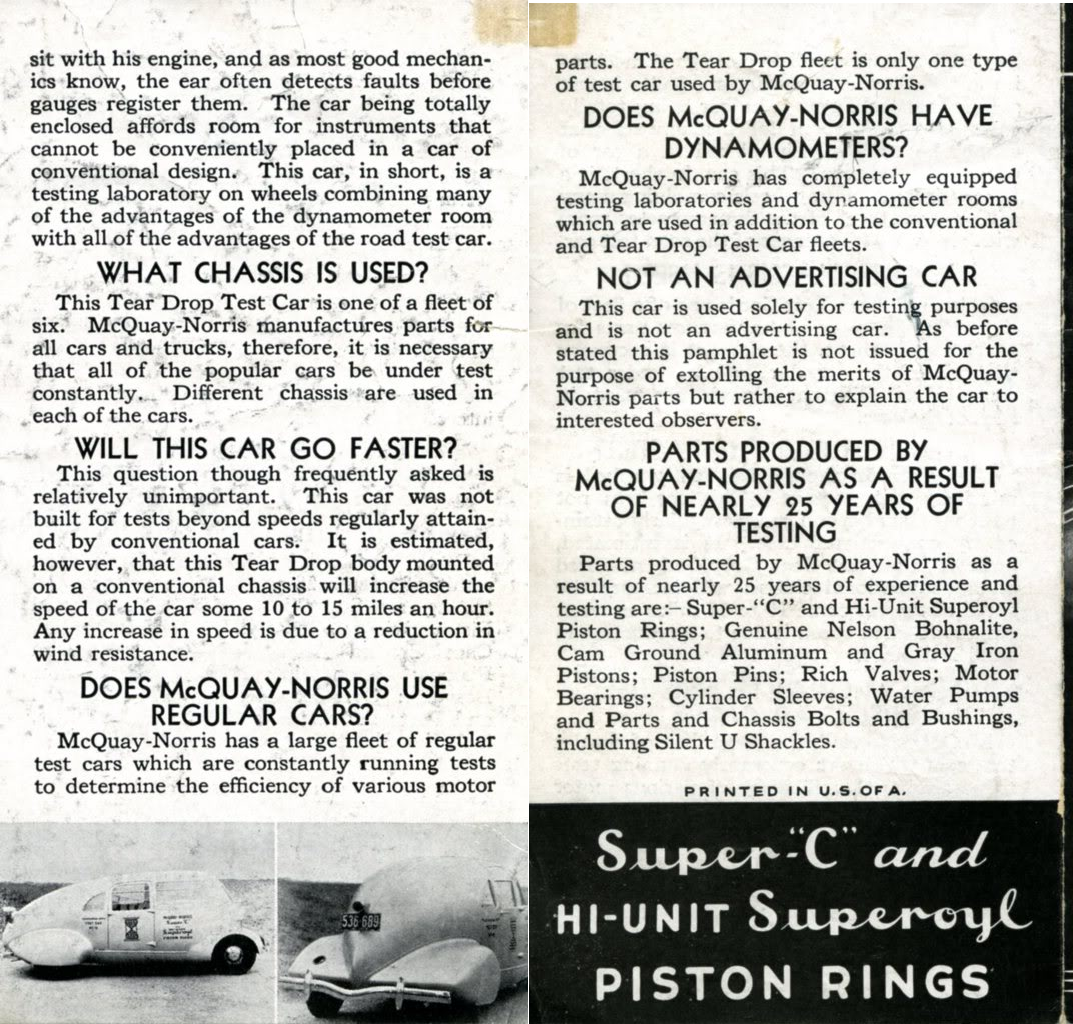
The cars lined up for a publicity shot
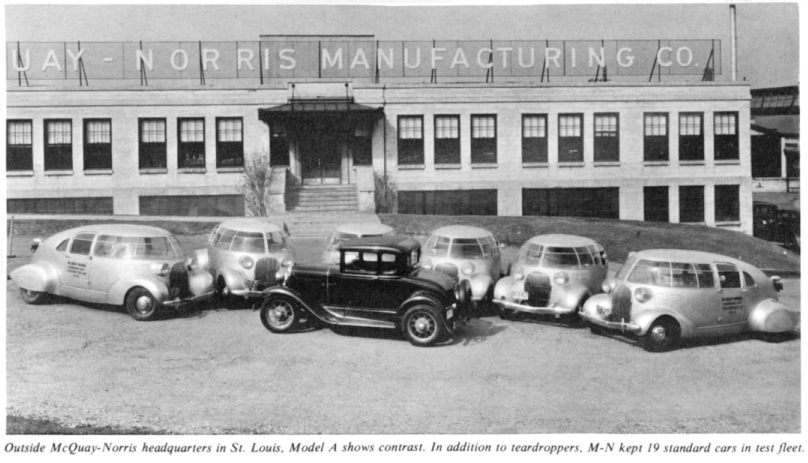
In the Lane Motor Museum
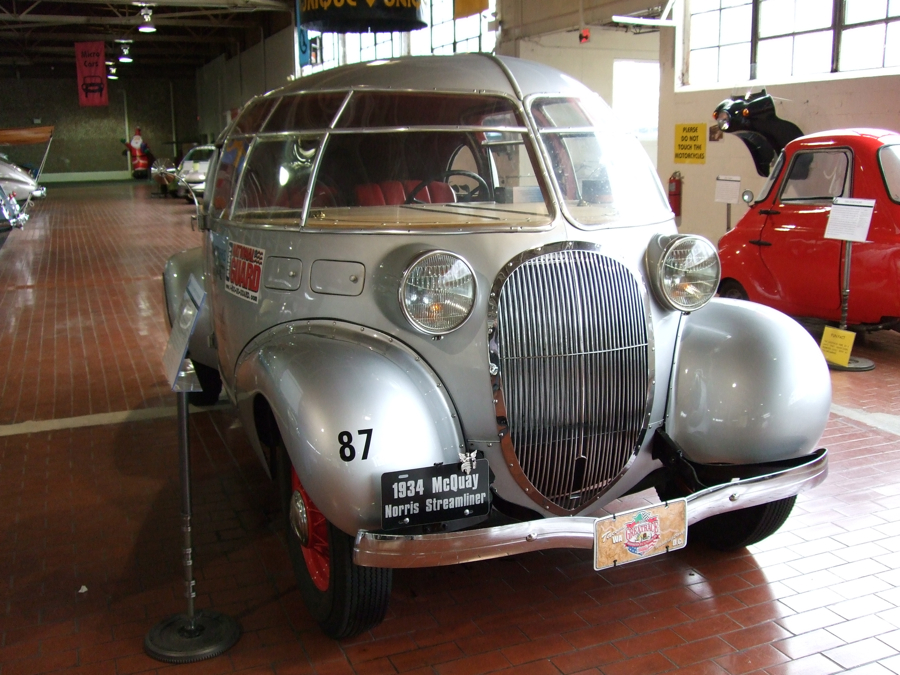
Here's No.9 completing a leg of the 2005 Great Race. Hmmm....after seeing this I'm assuming my first guess was right, and those two little doors were for ventilation.
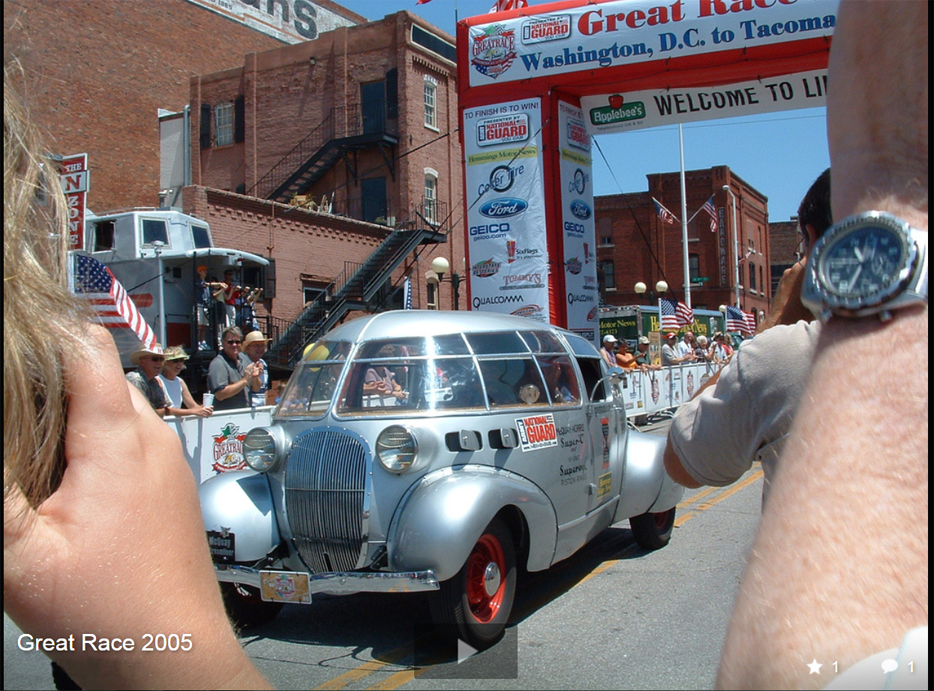
While I'm not particularly proud of this model, it's lumpy and segmented, I did enjoy doing the research. Hope you enjoy.
-
Great work as usual.
Weird car!
Visiblity seems really bad.
It seems to me if they reversed the front and back,
they would have had a real breakthrough aero-dynamically -
Great looking car. Perfectly modelled, with high degree of detail.
The article says:
"A drop of water falling through the air takes this shape naturally
because of the resistance of the air through which it is falling"That's confusing. I would think the law of gravity made a drop of water fall approximating a ball - with or without resistance of air.
I must find a sink and experiment
-
Very well done, Steve. Your post reads like a well written encyclopedia article, and is illustrated with your detailed Sketchup model to match. Love it.
-
Very cool model and render, Mr. M.

What rendering engine do you use, or just straight render from Sketchup with Photoshop postwork?
Have a great week!
_KN
-
@jpalm32 said:
Great work as usual.
Weird car!
Visiblity seems really bad.
It seems to me if they reversed the front and back,
they would have had a real breakthrough aero-dynamicallyThanks John.
Your comment got me to thinking. I think you're right. Keep in mind though, this was the early 1930's, they didn't know much about aerodynamics back then.
Anyhow, here's a quick-and-dirty body-on-backward version

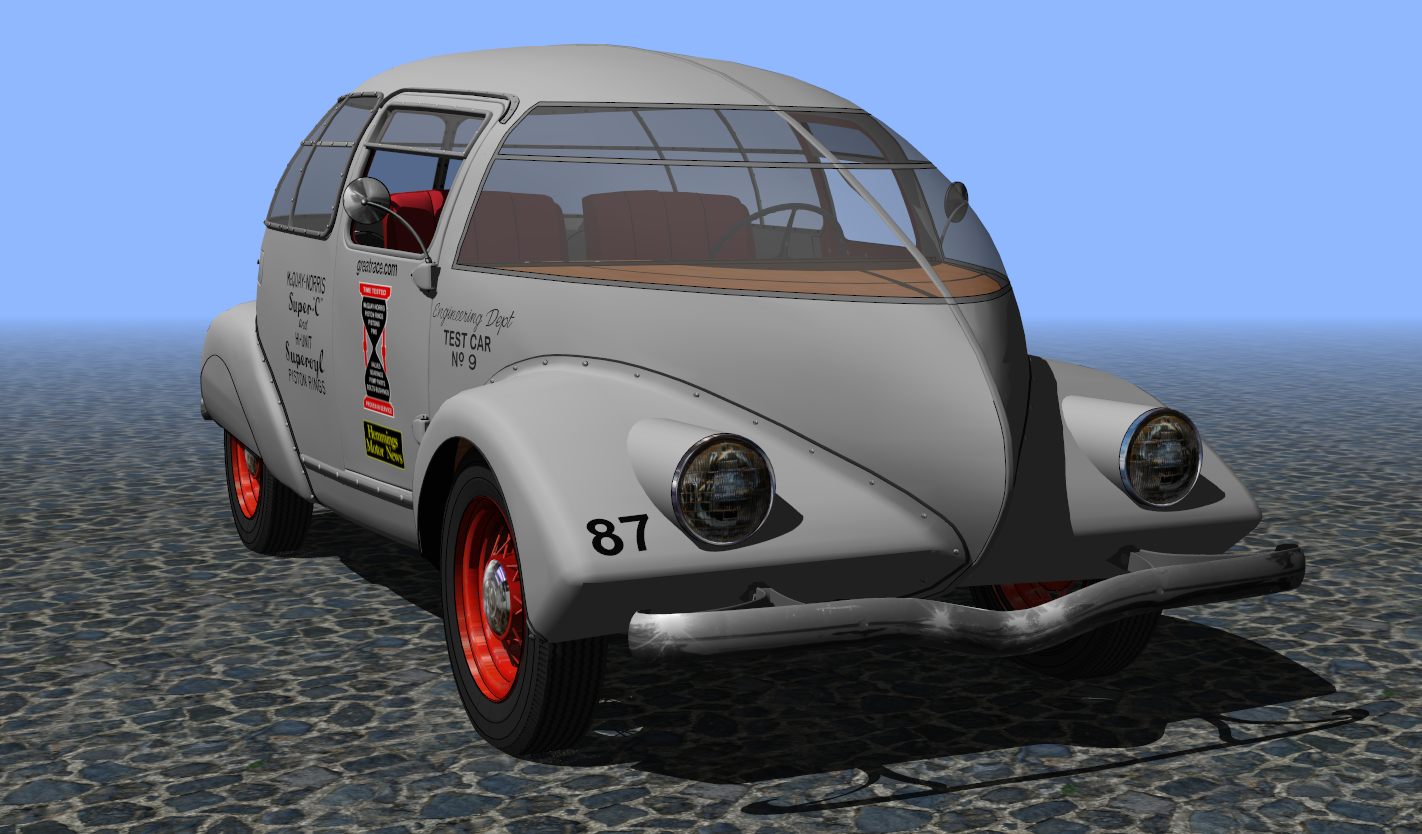
@adorno said:
Great looking car. Perfectly modelled, with high degree of detail.
The article says:
"A drop of water falling through the air takes this shape naturally
because of the resistance of the air through which it is falling"That's confusing. I would think the law of gravity made a drop of water fall approximating a ball - with or without resistance of air.
I must find a sink and experiment
I appreciate the kind words, Adorno.
Yeah, I always thought a drop of water assumed the most compact shape, a sphere. Turns out I was wrong.
http://ga.water.usgs.gov/edu/raindropshape.html
"Small raindrops (radius < 1 millimeter (mm)) are spherical; larger ones assume a shape more like that of a hamburger bun. When they get larger than a radius of about 4.5 mm they rapidly become distorted into a shape rather like a parachute with a tube of water around the base --- and then they break up into smaller drops."
Wow, I guess they're right -- you're never too old to learn something new
-
@d12dozr said:
Very well done, Steve. Your post reads like a well written encyclopedia article, and is illustrated with your detailed Sketchup model to match. Love it.
Thanks, Marcus.
For me half the fun when I start a new model is doing the research and getting to know the vehicle, not just it's appearance but it's history. Sorta bond with them after a while
 With this one being the last of it's kind I felt sorry for it, considering everything it's been through. I don't like for machines to be tossed aside to rust and rot after they've done their job. I remember all the choppers being pushed over the side of the ships after Viet Nam, and I felt they had earned a better fate. Same way with the thousands of aircraft in the Aircraft Boneyard in Arizona, just waiting to be sliced apart by that big blade. I know that seems silly, that they're inanimate objects, but that just seems cruel somehow
With this one being the last of it's kind I felt sorry for it, considering everything it's been through. I don't like for machines to be tossed aside to rust and rot after they've done their job. I remember all the choppers being pushed over the side of the ships after Viet Nam, and I felt they had earned a better fate. Same way with the thousands of aircraft in the Aircraft Boneyard in Arizona, just waiting to be sliced apart by that big blade. I know that seems silly, that they're inanimate objects, but that just seems cruel somehow 
Yeah, I are not normal (not even close)
@ken28875 said:
Very cool model and render, Mr. M.

What rendering engine do you use, or just straight render from Sketchup with Photoshop postwork?
Have a great week!
_KN
Thanks, Ken, but please, just call me Steve.
No rendering, no post-processing. Just a SU model. Raw, basic and unedited.
-
@unknownuser said:
No rendering, no post-processing. Just a SU model. Raw, basic and unedited.
That is first class!

You push the prog in its last entrenchments! Purism!
Purism! 
Do you know this guy ?
he makes crazzy cars and trucks ans bicyles...! -
totally weird dood...
-
@unknownuser said:
That is first class!

You push the prog in its last entrenchments! Purism!
Purism! 
The nice words mean twice as much when they come from you, Pilou. Thanks.
@unknownuser said:
Do you know this guy ?
he makes crazzy cars and trucks ans bicyles...!No, I hadn't heard of him. I watched a number of his videos, WOW, he is amazing! Such talent, and he makes it all look so dang easy (I hate him)

@krisidious said:
totally weird dood...
Yeah it are. Imagine how weird it looked back in the early '30's.
-
yes their original teardrop shape has the lowest drag coefficient of any known shape, many concept car designers are now adopting this shape.
what a fantastic model, just wow!!!

 you nailed every detail.
you nailed every detail. -
Very impressive.
-
Thanks guys.
I just found my next project, even weirder than the Streamliner (similar in that only three were made, with one surviving). Can't wait to get started, but it's gonna have to wait a while, other stuff around the house taking priority.
-
@hellnbak said:
Thanks guys.
I just found my next project, even weirder than the Streamliner (similar in that only three were made, with one surviving). Can't wait to get started, but it's gonna have to wait a while, other stuff around the house taking priority.
What is it?
-
@unknownuser said:
Do you know this guy?
he makes crazzy cars and trucks ans bicyles...!Scott Robertson, of course. I have a few books from him. Working in the game/movie industry, I have to know these guys (Scott and Neville Page). They are the founders of the famous Gnomon School of Visual FX.
Steve: I look forward to seeing more of your great models.
Best,
_KN
-
@olishea said:
@hellnbak said:
Thanks guys.
I just found my next project, even weirder than the Streamliner (similar in that only three were made, with one surviving). Can't wait to get started, but it's gonna have to wait a while, other stuff around the house taking priority.
What is it?
Glad you asked. It's a thingamabobbie that sorta resembles a whatchamacallit, but a little like a hootchamaflooie in some ways.
-
Thought so. Sounds spectacular!

-
@olishea said:
Thought so. Sounds spectacular!

Well, I don't know about spectacular, just hoping for ok. The tricky part is gonna be finding enuf reference photos of this thing to make it accurate. Seems like each vehicle I model has fewer and fewer photos available. When I get to the point where a car just has a name, no photos at all, now that's gonna be a challenge.
But then who's gonna know whether or not I got it right?
-
What about this one?

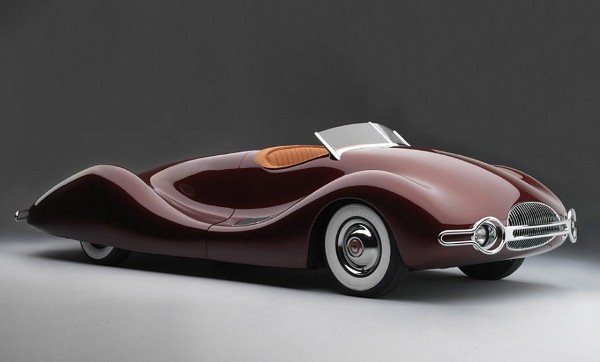
-
@gilles said:
What about this one?

Wow, 2 1/2 years work, $10,000 (1948 dollars), this was definitely a labor of love.
What's strange is that it says here http://www.supercars.net/cars/4688.html --
"The car was discovered in the desert pretty much intact in 2002"
Does that mean it was just abandoned in the desert? I'll have to check into this one some more.
Thanks!
Advertisement







